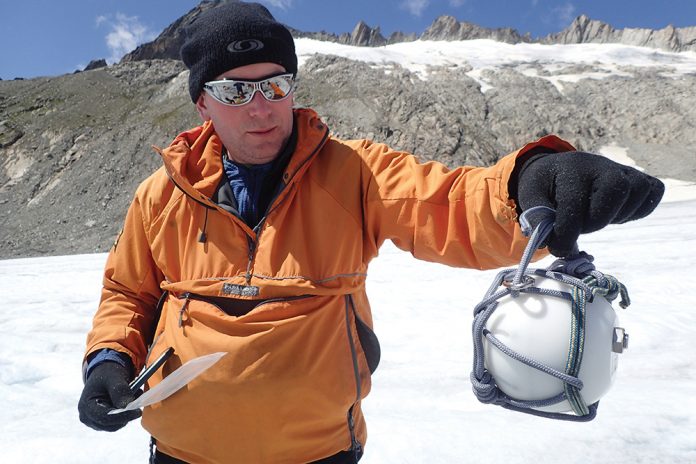Glaciers are the most important freshwater reservoir on Earth – around three-quarters of our freshwater reserves are stored in glacier ice across the planet.
At the poles, the large ice sheets covering Antarctica and Greenland contain enough stored water that if they melt, they will significantly raise global sea levels, causing widespread coastal flooding. With rapid increases in global temperatures as a result of carbon emissions, we are now losing many mountain glaciers altogether, and there is a real risk of losing very significant volumes of ice from the polar regions too.
A development with added value: Cryoegg
Glaciologist Liz Bagshaw and engineer Mike Prior-Jones, from the School of Earth and Environmental Sciences at Cardiff University in Wales, have developed an innovative new form of subglacial probe: Cryoegg.
Cryoegg is a wireless ball-like device containing a battery, sensors and a radio transmitter. Its almost spherical shape allows it to glide easily and smoothly through the water channels within glaciers. It is therefore very unlikely to get stuck. As Cryoegg is wireless, it can simply be dropped into a moulin or lowered into a borehole.
The three parameters of pressure, temperature and elec.trical conductivity are measured using sensors integrated into Cryoegg. The pressure sensor is a KELLER PA-20D (250 bar) pressure transmitter. It features a vacuum-sealed diaphragm and communicates with the microcontroller via a digital I2C interface. The transmitter delivers a 16-bit pressure value to the microcontroller but only utilizes half of the available range. The rest is used to report pressu.res slightly above the calibrated range. This means that the smallest reportable pressure interval is 7,6 mbar. Du.ring practical field tests, the KELLER sensor was even able to detect changes in water pressure with up to 0,1 bar accuracy. Separate, independent sensors are instal.led for temperature and conductivity measurements.
Field trials
Field trials of Cryoegg were carried out on Switzerland’s Rhône Glacier in 2019. The team attached Cryoegg to a rope and lowered it into a moulin for testing. As soon as Cryoegg reached the bottom of the moulin, the water pressure it was measuring using the KELLER PA-20D sensor appeared on the monitor. As the pressure conti.nuously dropped to zero over the course of an hour, the team was able to conclude the stored water was flowing out of the moulin.
Ice is also very transparent to radio waves, which is why glaciologists have long used radar to see through it.
A further field trial was carried out in the East Greenland Ice Core Project’s borehole. This showed that Cryoegg could return data through more than 1,3 km of ice, and that the sensors could withstand operation at -30 °C.
Future plans
Cryoegg team intend to return to the East Greenland Ice Core Project (EastGRIP) site in the coming years. This borehole is drilled into the North East Greenland Ice Stream (NEGIS), which is a very fast-moving section of the Greenland Ice Sheet. Understanding how the NEGIS responds to climate change is important in forecasting how quickly ice from the Greenland Ice Sheet will reach the sea and raise global sea levels. Once the EastGRIP ice core is completed, they will leave behind a 2,5 km deep borehole through which Cryoegg will access the environment beneath the ice sheet.
Cryoegg is currently undergoing further optimization at Cardiff University to enable it to cope with the high pres.sure beneath the NEGIS. Adapting the housing and fitting a KELLER 7LD sensor will enable robust measurements of water pressure reliably and in real time. The KELLER 7LD pressure transmitter could be the optimal solution for this. As well as its compact size, it also provides very reliable measurements, and its chip-in-oil technology makes it extremely robust against environmental influences. Here too, the I2C interface supports easy integration into the existing system. The low power consumption of the pressure transmitter also makes it ideal for use in battery-operated systems.
The aim of Cryoegg team is to use the latest technology to gain a better understanding of glaciers and how they work. This in turn will ultimately enable us to find solutions to maintain and effectively protect our glacier and polar regions long term.




